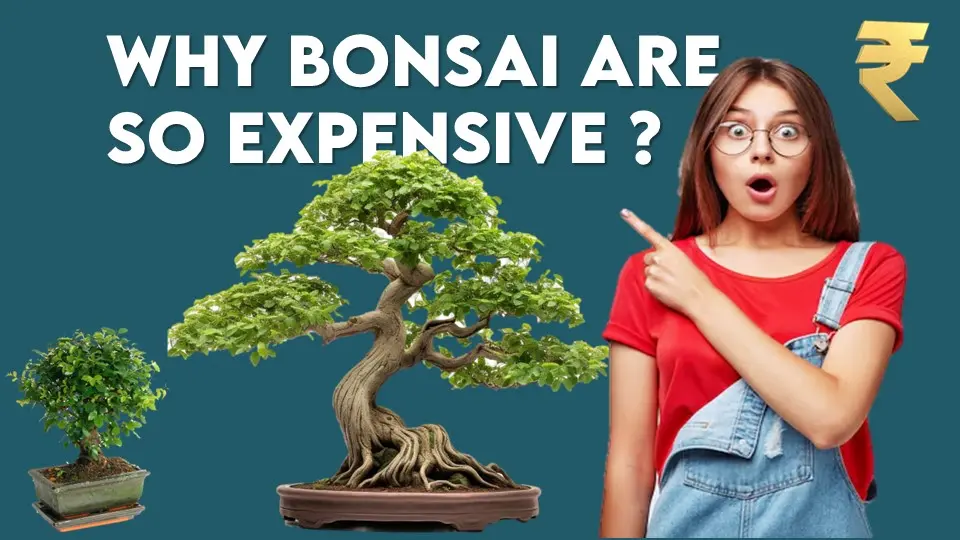So, here’s to another article on Bonsai trees that all should be aware of! The main question is Why are Bonsai Trees so Expensive? These are only ordinary trees and shrubs and not genetic dwarfs—that are trained by tying branches with cord and pruning roots and branches are what constitute the bonsai specimens. The practice of cultivating and training trees in realistic designs within trays, wooden containers, and ceramic pots dates back at least a millennium in China, where the art form first emerged. But the Japanese have been the ones who have pursued and perfected bonsai the most.
Dwarfed potted trees were first mentioned in Japanese literature in the Kasuga-gongen-genki (1309), a pictorial scroll created by Takashina Takakane. The nature is the direct inspiration for Bonsai. So, here is a brief answer to why are bonsai trees so expensive and how one can grow them.
Rarity and Uniqueness of Bonsai
Because of their unique and captivating qualities, bonsai trees are thought to be uncommon. These include the time and work needed in growing them, the limited availability of certain kinds of trees that work well for bonsai, and the skill needed for carving and care for these little works of elegance.
Primarily, bonsai trees are uncommon due to the extreme care and attention they require. Bonsai is also known as the true labor of love, as it involves meticulous pruning, wiring, and shaping of the tree to achieve the desired aesthetic.
It requires years of long periods, if not decades, for this process to produce the desired result. Every bonsai tree stands as evidence of the determination and dedication of its caretaker.
Second, only a few tree species that are appropriate for bonsai maintenance are widely available, which contributes to the scarcity of bonsai trees. Not all trees are suitable for bonsai; some need certain traits like tiny leaves, flexible limbs, and a natural susceptibility to root confinement and pruning. Bonsai trees are limited by nature because of these particular characteristics, which limit the variety of kinds of trees that can be utilized.

Furthermore, the value of bonsai trees as collector’s goods might be linked to their rarity. Some bonsai trees are rare because of their age, stature, or distinctive qualities. Owing to their high market value, these rare species are highly sought after by both bonsai collectors and enthusiasts. These bonsai trees are very desirable assets due to their exclusivity and rarity in nature, which ultimately increases their value.
How to Grow Bonsai?
Based on cuttings generated from other bonsai, most bonsai are created. Thus, they are initially 2 mm in diameter and approximately 10 cm long. After that, the cuttings are planted in topsoil. The cuttings are shaped and maintained for the following five years or more to produce beautiful bonsai. All of the small trees are checked for water regularly during this time, and they undergo weekly feedings using bonsai fertilizer.
The main reason why bonsai trees are so expensive is that they are based on cuttings generated from other bonsai. Thus, they are initially 2 mm in diameter and approximately 10 cm long. After that, the cuttings are planted in topsoil. The cuttings are shaped and maintained for the following five years or more to produce beautiful bonsai. All of the small trees are checked for water regularly during this time, and they undergo weekly feedings using bonsai fertilizer.
Now, the shaping of the bonsai comes. One started giving them shape after roughly two years of development. To achieve a beautiful, twisted shape, the bonsai must be carefully wired and replanted. Every week, this wire needs to be adjusted to make sure it does not penetrate through the tree’s trunk.
Usually, one is able to take out the wire from the main trunk after four to five years. However, it remains on the branches until they gain sufficient strength to maintain the intended posture. Every week, the bonsai are fed and trimmed.
We transplant each of our bonsai every one to three years to maintain their health. Every bonsai should have frequent inspections for pests and illnesses, which should ideally be avoided.
Some trees are available for buy five years after cuttings were made. To ensure they are in excellent shape, plants are repotted and quality verified! For an additional three or even twenty years, some bonsai are grown. One continued to check them daily for water during that time.
Comprehensive Training and Maintenance
Specialized maintenance is a much-needed thing for small trees that are planted in pots, such as bonsai. In contrast with houseplants and other aspects covered in container gardening, most tree species produce roots that can reach several meters in length and form root structures that hold several thousand liters of soil.
On the other hand, a standard bonsai container has a maximum dimension of less than 25 centimeters and a volume of 2 to 10 liters. Large-scale branch and leaf (or needle) growth occurs naturally in trees. When fully grown, wild trees can reach elevations of five meters or more, while the largest bonsai rarely grow to heights of one meter, and a vast majority of specimens are much smaller.
Numerous additional components of tree biology, including nutrition, transpiration, pest resistance, and maturation, are all affected by these size disparities. Some of the maintenance tips are as follows:
- Periodic irrigation is necessary by the soil requirements of the bonsai species, which can be dry, moist, or wet.
- Re-potting needs to take place at intervals determined by each tree’s age and vigor.
- Particular tools have been created to meet the unique needs of bonsai maintenance.
- While the structure and fertilizing of soil for bonsai trees vary, the soil in bonsai plants is often a loose, quickly-draining mixture of materials.
- When keeping a bonsai outdoors, the location and method of overwintering vary depending on the species, as they have different needs for light conditions. Because indoor environments are typically dry, only a few of the traditional bonsai species may survive in a typical residence.
Also Read
Higher Demand: The Natural Worth of Bonsai
Yes, there are many situations in which bonsai trees mimic “Trees of Life.” These tiny/small trees, are a tenacity, fortitude, and the eternal beauty of nature, perfectly showing the essence and beauty of their larger counterparts.
Each bonsai is a tale of careful attention to detail, bridging generations and cultivating a strong connection with the natural environment. Growing bonsai brings us calm and fulfillment by permitting us to experience the cycles of development and change.
All over the world, bonsai trees are very popular as a hobby in recent years, especially in countries like China and Japan where the preservation of the environment is highly valued.

Cultivating bonsai plants offers multiple benefits, such as improving interior design, protecting and maintaining the ecology, and creating a healthier environment because of their safety, all of which have an impact on the bonsai industry worldwide. It also forms a vital component of economic expansion and is an important feature of sustainable development.
The other important known benefits include:
- Certain plants, such ficus trees, greatly improve the inside air quality through the elimination of indoor air pollutants.
- Indoor bonsai plants provide you the comfort of being involved as one take care of them because they serve as companions. It’s just like having a conversation partner close. This has a vital effect on decreasing blood pressure, reducing stress, and enhancing our overall feeling of welfare and confidence and enhancing our overall feeling of welfare and confidence.
- Pruning, trimming, and following the growth cycles of bonsai trees take a great deal of patience on your part because they grow much more slowly than ordinary indoor plants. One won’t get immediate rewards; it’s more like an investment for the future. As a result, one naturally develop the virtue of patience.
Longevity and Generational Value
Trees in nature do not age away. Typically, external forces like storms, lightning strikes, or environmental stresses lead them to decay and eventually fall, which is how they die.
Bonsai trees, on the other hand, have protection from these dangers and can live much longer than they would in the wild. The most curious thing about growing bonsai is its longer life expectancy.

Many instances of bonsai trees that have been tended to by multiple generations of bonsai artists for millennia exist. The Ficus bonsai at the Crespi Bonsai Museum in Italy, which is believed to be over a millennium old, is among the most well-known examples. This ancient tree is the epitome of how long-lasting and resilient bonsai can be with regular care.
A white pine bonsai at the Mansei-en Bonsai Nursery in Japan, which has been tended after by the same family for more than 400 years, is another remarkable example. This bonsai, in many countries like Japan, is a live example of the classic beauty and long-lasting appeal of bonsai art.
Also Read
Luxurious Item: Bonsai (Planted in a Pot)
We are often asked this, why bonsai are so expensive? The previously mentioned description of bonsai cultivation is only a basic summary. Every bonsai requires ongoing care and requires a minimum of 5 years of maintenance and occasionally up to 25 years! Over a month, each bonsai needs hours of work, but we don’t just have one. Naturally, a bonsai’s age has a very important effect on its cost. In general, more labor has gone into a bonsai the older it is.
Because so much care goes into keeping each one in top condition and ensuring that it remains continually healthy, bonsai are expensive. Cultivators greatly hope that their clients value the time and labor that went into creating their bonsai!
Wind Up
At the end of this article, the time and labor required to nurture these bonsais, the scarcity of appropriate tree species, the creative skill needed to shape and maintain them, and their value as collector’s items all contribute to the rarity of bonsai trees. All of these components work together to create something genuinely remarkable and appealing in bonsai trees. Thus, if one is thinking about taking up bonsai cultivation, accept that they are distinctive and enjoy the fulfilling experience of caring for these tiny wonders of nature. They truly represent the “Tree of Life,” as they can be inherited by families as living legacies and are the answer to why are bonsai so expensive.
Latest Post
- October Issue 2025- Times of Agriculture Magazine
- Top 10 Pesticide Companies in the World
- September Issue 2025- Times of Agriculture Magazine
- Top 15 Fertilizer Companies in the World
- Top 10 Vegetable Farming Profit Per Acre in India
- August 2025 : Times of Agriculture Magazine (AgriVoltaics Farming)
- Button Mushroom Farming: Infrastructure, Cultivation, and Profitability
- Sahiwal Cow: Characteristics, Milk per Day, Price and Origin
- July 2025 : Times of Agriculture Magazine
- June Issue (2025) – Times of Agriculture Magazine
- How to Create Modern Commercial Greenhouse Agriculture
- REACH NEW HEIGHTS WITH YOUR BUSINESS AT VIETSTOCK EXPO & FORUM 2025














